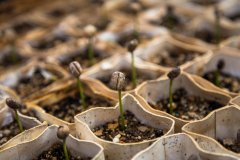Coffee History, Origin, Development and Culture found that Coffee spread to Europe

Legend of Coffee
Many legends have mentioned the excitatory effect of coffee, the oldest of which is that around 850 AD, a young shepherd in Ethiopia found that his goat became particularly energetic after eating a certain fruit.
After tasting the fruit, a group of monks, feeling bitter and disappointed, threw the fruit into the fire, which soon gave rise to a strong fragrance. The monks were curious and boiled the roasted fruit into a drink. The monk thought it was a gift from God, because people were awake even in the middle of the night when drinking the drink.
Another legend is about Gabriel, who brought the elixir to the dying prophet Mohamed. Because of the power of the medicine, he unloaded 40 knights and built an unprecedented Islamic empire.
Found coffee
The culture of coffee drinking dates back to the 11th century, when coffee was first imported from Ethiopia to Arabia, and the Persians were enthusiastic about the excitement of this new "Islamic wine" because alcohol was strictly prohibited in Islam, and the word "coffee" came from the ancient Arabic word "gahwah".
In the second half of the 15th century, coffee spread to the Arab Empire through the cities of Mecca and Medina and to Cairo in 1510.
In the first half of the 16th century, the Osmanic empire reached its heyday, and coffee became popular in Arabia, Asia minor, Syria, Egypt, and southeastern Europe. The first cafe opened in Damascus and Aleppo in 1530 and 1532.
Coffee conquered Europe
In 1615, the merchant of Venice returned to Western Europe with the first bag of coffee beans, and the aroma and excitement of coffee quickly became the most popular drink. As a result, coffee shops sprang up in Europe, and the middle class constantly wanted to promote coffee. Everywhere extolling the refreshing effect of coffee, this refreshing effect turned alcoholics into reliable labor, and Dutch and British crew exported the plant coffee to other colonies.
When the Turks were forced to stop the siege of Vienna in 1683, they left behind 500 bags of coffee, which was used by a Polish businessman to open the first coffee shop in Vienna.
The popularity of coffee has led to the growth of a large number of coffee trees. As early as the end of the 17th century, coffee was successfully planted in greenhouses. In 1714, one of the coffee trees was dedicated as a gift to Louis XIV in France. This plant has always been regarded as the ancestor of coffee trees.
Coffee in the 20th century
At the beginning of the 20th century, Brazil was the largest producer of coffee in the world. now almost all coffee production comes from Central America, Brazil and tropical South America. the world produces about 100 million bags of coffee a year. Brazil accounts for more than 1% of the total output.
Home coffee roasting was eventually replaced by processed commercial products, and in Japan in 1901, Dr. Sartori Kato presented the first soluble coffee powder. In 1938, Nestl é established the foundation for the commercial market of coffee powder (instant coffee).
The global consumption of coffee beans in the past 250 years reflects the growth rate of coffee.
1750: 600000 bags, 1850 Vera 4 million bags, 1950: 35 million bags, 1995: 94 million bags, 2000: 130 million bags.
The demand for coffee has made coffee the second most important trade commodity after petroleum products. This trend is accompanied by overproduction, incineration of excess stocks, price collapse, the world economic crisis, the decline in consumption in the second World War, and the establishment of a global coffee agreement to stabilize coffee prices. In Germany after World War II, coffee became a symbol of economic restructuring and economic wonder. Being able to afford coffee means spending power.
Important Notice :
前街咖啡 FrontStreet Coffee has moved to new addredd:
FrontStreet Coffee Address: 315,Donghua East Road,GuangZhou
Tel:020 38364473
- Prev

Planting, harvesting, treatment, drying, grinding, export, cup testing, baking, grinding, cooking
Planting growing coffee beans is actually a kind of seed. When dried, roasted and ground, it can be used to make coffee. If the seeds are not processed, they can be planted and germinated into coffee trees. Coffee seeds are usually planted in big beds in shaded nurseries. Always water the seedlings and block the bright light until they thrive. Planting is often carried out in the rainy season
- Next

Kenyan Coffee Bean Variety and Flavor characteristics of Dedan Kimathi University Coffee Bean
The background and flavor of Kenyan coffee beans in the 19th century, Kenya was still under the control of the British colonial government, and the colonial rulers brought oppression and exploitation, under many unequal treatment, the Kenyan people, who did not have the concept of state organization at that time, from the original scattered state gradually developed the idea of modern consciousness and nation-state. So, between 1956 and 1960, the military took place.
Related
- Beginners will see the "Coffee pull flower" guide!
- What is the difference between ice blog purified milk and ordinary milk coffee?
- Why is the Philippines the largest producer of crops in Liberia?
- For coffee extraction, should the fine powder be retained?
- How does extracted espresso fill pressed powder? How much strength does it take to press the powder?
- How to make jasmine cold extract coffee? Is the jasmine + latte good?
- Will this little toy really make the coffee taste better? How does Lily Drip affect coffee extraction?
- Will the action of slapping the filter cup also affect coffee extraction?
- What's the difference between powder-to-water ratio and powder-to-liquid ratio?
- What is the Ethiopian local species? What does it have to do with Heirloom native species?

